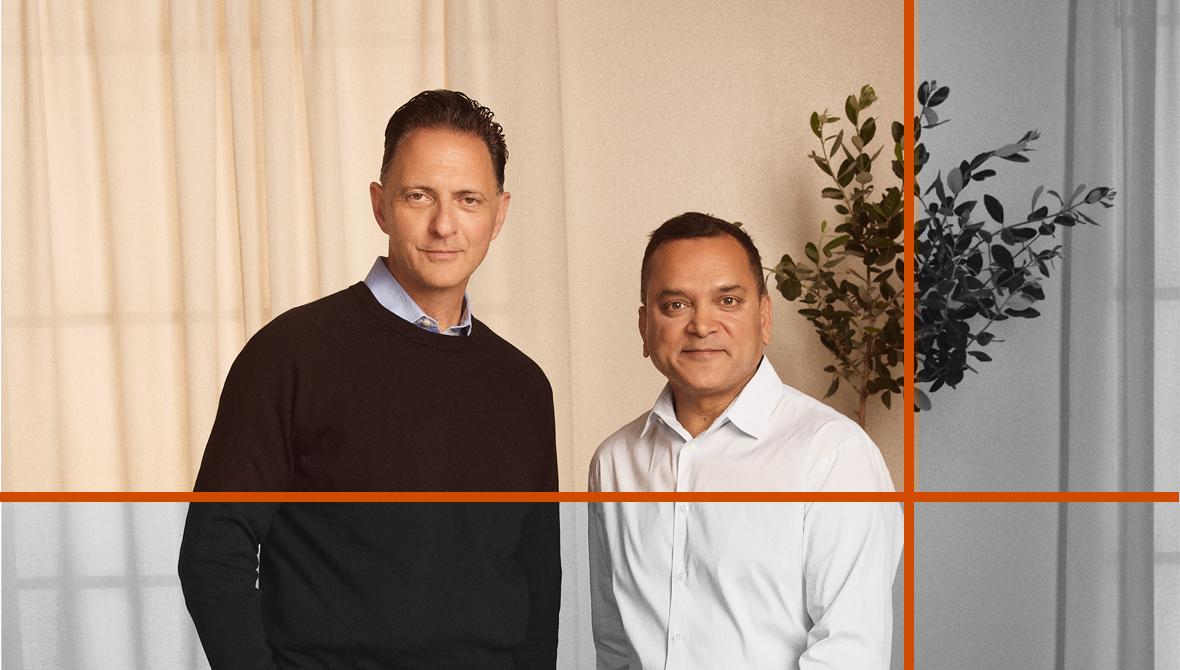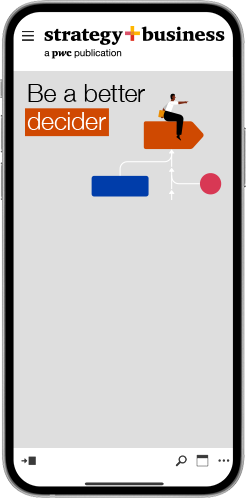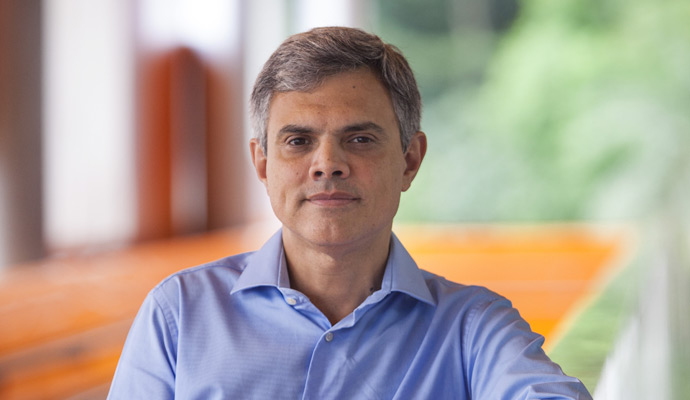e.l.f. Beauty and rhode are giving the beauty business a makeover
CEOs Tarang Amin and Nick Vlahos discuss how they’re staying true to their shared vision as expectations rise.

This interview is part of the Inside the Mind of the CxO series, which explores a wide range of critical decisions faced by chief executives around the world.
In May 2025, two of the most talked-about names in beauty joined forces. The headline-making deal brought together e.l.f. Beauty, the company that began by selling $1 makeup online more than two decades ago and turned drugstore makeup into a viral phenomenon, and rhode, a minimalist skincare line launched by Hailey Bieber—an influencer with tens of millions of followers.
Over the years, e.l.f. has grown into a $1.3 billion business (FY25) with more than two dozen consecutive quarters of market-share gains and net sales growth, expanding at a rate roughly four times that of the global beauty market. More recently, rhode became a nine-figure brand in just three years and with only ten products before being acquired by e.l.f. and making its retail debut at Sephora in September. Though established players like L’Oréal, Estée Lauder, and Coty remain far larger, with even single-digit growth translating into meaningful progress at their size, what has set e.l.f. and rhode apart is their ability to connect with Gen Z and other young consumers in ways incumbents have struggled to replicate.
Both brands have leaned into cultural and digital fluency. e.l.f. has used social media to fuel its rise, marketing affordable alternatives to premium products that regularly go viral in “get-ready-with-me" and makeup-haul review videos. rhode, meanwhile, has tapped into its founder’s celebrity profile—and related marketing power—to promote a minimalist aesthetic and a tightly edited range of products. Together, these companies are betting that the ability to move quickly with their communities is a smart path to relevance and to growth in today’s rapidly changing consumer economy.
CEOs Tarang Amin and Nick Vlahos recently spoke with strategy+business about what it takes to stay close to your customer while scaling fast, how they’re using AI for sharper insights, and why keeping an entrepreneurial spirit alive may be their most important advantage.
The following is an edited version of the conversation.
S+B: When e.l.f. and rhode came together, what did that moment mean for you?
Tarang Amin: We’d been watching rhode for some time, and the way the brand resonated with consumers was unlike anything I’d seen. When we finally sat down together, the philosophies, the culture, the focus on community—it all just clicked. That alignment made it a no-brainer.
Nick Vlahos: Tarang and I had worked together more than 20 years ago, so there was already a foundation. But the turning point was when we sat down with Hailey. We weren’t just talking business; we were talking about where our heads and hearts were, and what we wanted to build. From the beginning, it was clear that e.l.f. valued the same things we do: respect for founders, creativity, community. That gave us the confidence this was the right match.
S+B: In practical terms, how do you plan to create new value?
Amin: We’re building a portfolio of complementary yet distinct brands that all share one thing in common: they’re fast-growing and have tremendous white space ahead. Both e.l.f. and rhode are coming from positions of strength. At e.l.f., our gross margins are over 70%. rhode is already accretive to the company. So it’s not just top-line growth—it’s disciplined growth on both the top and bottom lines.
Vlahos: From our side, the most important thing is accessibility. We’re a three-year-old brand, and up until now we’ve been direct-to-consumer only. But in September, we launched in Sephora across US and Canadian stores. Over time, that’s going to be a huge unlock. And when you look at e.l.f.’s capabilities—retail relationships, global footprint, executional excellence—those are areas that can help us accelerate what we’re already doing digitally.
S+B: You’ve grown fast. How do you plan to keep up that momentum?
Vlahos: It’s definitely a challenge, and I think overcoming it starts with humility and curiosity. We focus on listening, learning, and then acting on what we hear. We’re also fortunate to work with founders like Hailey who are actively shaping the creative vision, and we’re pushing to keep evolving instead of repeating ourselves.
Amin: I’d add that even with our success, we see both challenges and opportunities ahead. Every acquisition has to be more than a financial fit. It has to match our culture and keep us agile. The key is never getting too comfortable and always adapting as fast as our consumers do.
S+B: How do you stay up to date with consumers’ evolving behavior?
Vlahos: It comes down to turning consumer signals into action. To share one example, we noticed people mixing our blush with our barrier restore cream—blending hydration with color in a way that worked for them. So we leaned into the insight and developed a hybrid blush that delivers both skin benefits and pigment. Because we’ve invested in our own labs and innovation teams—including four chemists and a packaging engineering team in Santa Monica—we’re able to go from signal to shelf at speed. We watch. We listen. Then we build. That’s how a consumer hack becomes a product, and how we keep delighting our community with what’s next.
Amin: It also starts with having a team that reflects the community we serve. At e.l.f., 76% of our employees are women, 74% are Gen Z or millennials, and 44% come from diverse backgrounds. So we don't need to rely on focus groups. Our team reflects our community. They live how our consumers live—and that gives us better signals than a survey. And we live where they live. We were the first beauty brand on TikTok, we have a dedicated channel on Twitch, and we have the top branded experience on Roblox. That connection helps us spot trends as they’re happening.
S+B: Looking ahead five years, what do you hope to achieve together?
Amin: Global accessibility. Every retailer we’ve launched with in the past 18 months, we’ve entered as the number one or number three brand. Much of our social feed already comes from outside the US, and rhode already has 20% of its business internationally while Hailey has 74% of her following abroad. There’s enormous demand still untapped.
Vlahos: From day one, Hailey’s vision was accessibility—not just in geography, but in value, quality, and price that consistently delight consumers. Our pop-up data shows the opportunity: 60% of visitors had never bought rhode before. That tells us we have huge room to grow awareness and reach, well beyond Hailey’s personal brand.
S+B: Can you reflect on the secret sauce competitors can't seem to replicate?
Amin: We’re a passionate team of owners in a high-performance culture. Every e.l.f. employee gets equity every year. We train extensively on teamwork and accountability. And then there’s our value proposition: taking the best of beauty and making it accessible, with powerhouse innovation and disruptive marketing. That combination is hard to copy without rethinking your entire enterprise.
We’re also constantly building our superpowers—not just premium quality and value, but products that are vegan, cruelty-free, and fair-trade certified. All of that comes directly from listening to what our community values. Those choices build lasting trust and make it harder for competitors to replicate.
S+B: How is AI changing your approach to consumer insights and innovation?
Amin: We look at AI in three ways. First, automation—taking repetitive tasks off our teams’ plates so they can focus on creativity. Second, content—generating more personalized content at the scale our community demands. And third, community—both management and insights. Today, if you DM e.l.f., it’s answered through AI, which frees up our community managers to go deeper. We even have a private, internal AI writing tool, and it’s become second nature for our team to use it in real time during meetings.
Vlahos: We’re leaning into AI more from an analytical lens—how to measure ROI in marketing, how to optimize spend, how to allocate resources wisely. We’ve both seen different waves of tools and technology over the years. There’s always an adoption curve. The question is how to deliver today while positioning for acceleration tomorrow.
S+B: How are you navigating economic uncertainty and tariff concerns?
Vlahos: When we raised lip pricing recently with an improved formula, we explained it openly and in advance. We’re also clearly focused on innovation that gives multiple benefits in one product. Our new barrier butter, for example, helps with fine lines and has the eczema seal of approval. That’s broader value at a fair price.
Create a team of owners, with a high-performance culture that reflects the community you serve. And never lose sight of delighting your consumers—that’s the real strategy.”
—Tarang Amin, e.l.f. Beauty
Amin: Consumers are being very choiceful right now, so we want to be radically transparent. In 21 years, we’ve only raised prices three times. When we announced a dollar increase this August, we explained why—months in advance, across all our social channels. The response was 98% positive, because consumers appreciated the honesty.
S+B: What advice do you have for other consumer goods leaders?
Vlahos: Focus on being interested rather than interesting. Stay curious. Keep learning. Apply what you learn. And remember: what got you to the party won’t keep you there. The leaders who watch, listen, and build are the ones who stay ahead.
Amin: Create a team of owners, with a high-performance culture that reflects the community you serve. And never lose sight of delighting your consumers—that’s the real strategy.
Author profiles:
- Ali Furman is the consumer markets industry leader at PwC and an M&A partner.
- Paul Leinwand is a principal at PwC US, a global managing director at Strategy&, and an adjunct professor at Northwestern University’s Kellogg School of Management.
- Jen Swetzoff is an editor at PwC.



